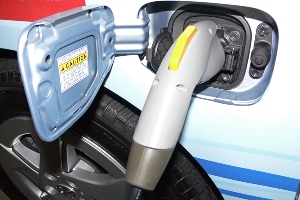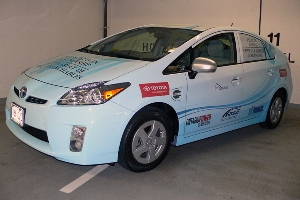

2012 Toyota Prius PHV
Based on the world’s most popular hybrid vehicle, the Prius PHV is designed to deliver a range of more than 13 miles and a top speed of almost 62 mph on battery alone. In addition, an onboard Atkinson-cycle gasoline engine enables the car to revert to hybrid mode and operate like a regular Prius, giving the vehicle the driving range and performance American and Canadian drivers demand from today’s automobiles.
The Toyota Prius PHV is expected to achieve a fuel mileage rating in the area of 135 mpg and CO2 emissions of 41 g/km under specified driving conditions (combined electric vehicle and hybrid vehicle modes). Compared to the typical conventional midsize automobile, driving a Prius PHV for one year should reduce fuel consumption by 436 gallons (83%) and CO2 emissions by almost 4,000 kg (or 4 tonnes).
Spending time behind the wheel of the Prius PHV, I find little difference with the regular Prius Hybrid. Acceleration is excellent, braking ability on par with other vehicles in this class, and there is no disparity in roominess or comfort.
A multitude of electronic gauges monitors all aspects of what’s going on mechanically, making it easy to track where you are in the cycle of electric power. With a limited cruising range of 12 miles in electric mode, it is not designed for long distance travel. But Toyota claims the average American commutes 10 miles per day, so it should, in theory, provide more than adequate power. Cold weather is certain to affect performance and is one of the reasons why it is so important to test in the northern U.S. states and Canada.
In total, 150 vehicles will be evaluated in the U.S., and 600 worldwide (15 in Canada), with TMS and the U.S. Department of Energy’s Clean Cities Program managing the long-term evaluation of the vehicles. If first impressions are worth anything in a long term test, the Prius Plug-In Hybrid should be a dynamic winner in the race to drive without the need to depend on petroleum-based fuels.
“By taking steps toward accommodating electric vehicle use, Georgetown continues to advance our sustainability goals, including the reduction of our carbon footprint,” said Karen Frank, vice president for university facilities and student housing at Georgetown.
“We are thrilled to be partnering with Clean Cities and Georgetown University to gain driver feedback on this new technology. These types of partnerships and programs are critical as we strive to bring advanced-technology and alternative-fuel vehicles to market that meet customer wants and needs,” said Jaycie Chitwood, manager of Advance Technology Vehicles, TMS.
Recharging the Prius PHV requires 3 hours with a standard 110V outlet, or as little as 90 minutes with a 220V connection. Georgetown University has installed two new vehicle charging stations which will be used during the evaluation period. These are located below the new LEED-certified Harris Building. Along with advancements in automotive technology, developments in architectural designs are helping lead the way in building a better tomorrow for future generations.
Is the world ready for an electric vehicle? The answer at this point is no. Government infrastructure is slowly coming alongside and refueling stations are starting to make their appearance within certain geographical areas, but it will be several years yet before we start to feel their impact.
This does not mean, however, that we shouldn’t pursue a plan of moving toward sustainable mobility. As plug-in power becomes more readily available in downtown areas, and garages are equipped with 220 volt charging stations, the switch will slowly flip towards more electric powered vehicles.
On that note, Nissan will soon introduce the LEAF, and Chevrolet is counting on the success of Volt, (as is Mitsubishi with i-MIEV), so the stage is set. My test drive of the Prius PHV in Vancouver, B.C. proved there is a market for this type of automobile and it is only a matter of time before we start to see more electric cars and less gasoline and diesel powered automobiles driving the future. Brighter days for the automobile are ahead!
No comments:
Post a Comment